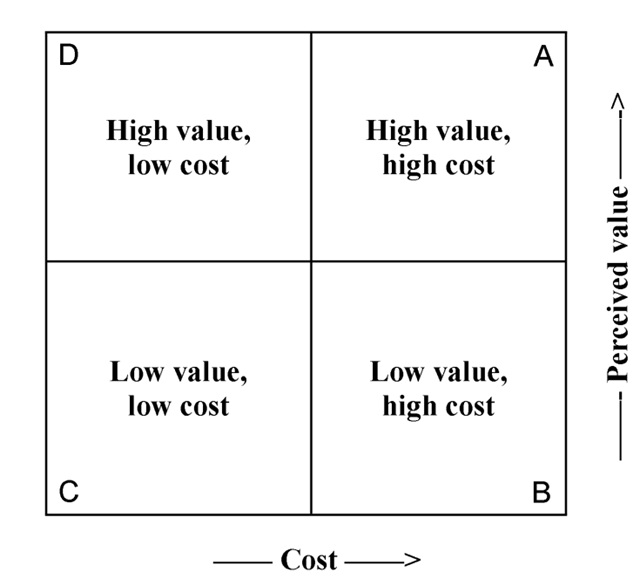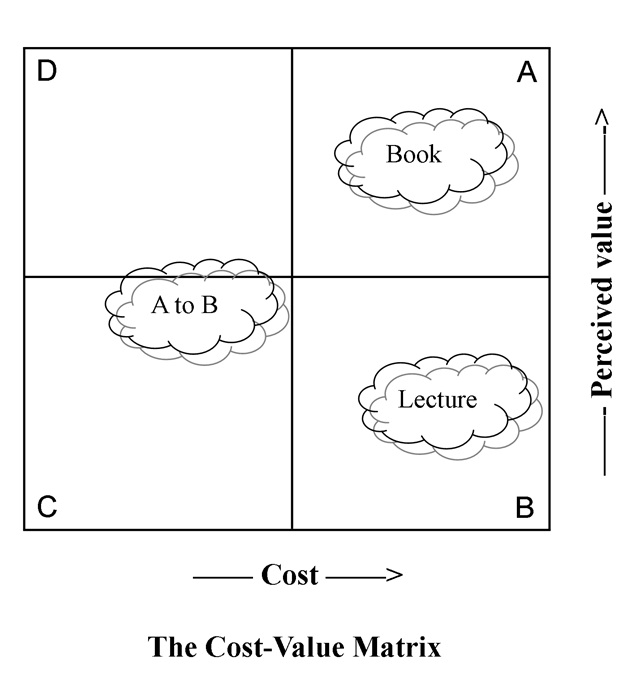Stephen Walker reviews the marketing of the value proposition and how a product positioning plan can achieve what you want.
Introduction
What does the 'value proposition' actually mean? You could expand the phrase to say 'what value the client gets from the product and at what cost'. The cost is at least a real number, ignoring some of the client’s own costs relating to taking time away from the main job. How do you define value though? Value exists in the mind of the client and, as such, is a function of marketing. Marketing is used to create a cost vs. value proposition.
The Matrix

The characteristics of each box are clear. My own business should be positioned in Box A. Most of our work is of a bespoke nature and there is a 1:3 ratio delivery to preparation time. The cost of one client-facing day has to cover four days work.
Box B is not a good marketing outcome. The perception of the value of some products has changed rapidly due to technology. It is now apparently possible to buy standard training courses from the internet, re-brand them and pass them off as your own. This practice has damaged the entire training sector by making the clients very suspicious and driving down the perceived value.
The next box, C, is interesting. We tweet every hour every day and have quite a sizeable following now. Not every tweet is relevant to everyone but they are available at no cost. What do you think about the last box, D? Is it a good idea to sell a highly-valued product at a low cost? A marketing analysis of where your products lie on the matrix is worthwhile. You will probably need to repeat the analysis for each product if its market is significantly different.
Get a real insight by talking to your clients (not a bad idea anyway!) about the positioning of your products. Failing that, you could set up a focus group and ask for their perceptions.
Perceived value

Let’s use BMW to demonstrate product positioning and the marketing processes that produce the result. I’m not naturally a car lover. Cars are a means of transport from A to B. I want a reliable car that will keep me safe and comfortable. So I would put my BMW value in box C.
When I studied for my marketing diploma one of my lectures used BMW as an example. The BMW advertisements are classic product positioning examples. However what the lecturer showed us was a BMW advert over dubbed with a sound track for a Ford Capri boy racer car. The soundtrack fitted the visual imagery. Perhaps BMW have identified the boy racer in us and are showing those images. It would not be appropriate to promote a car as a boy racer’s dream so the message is purely visual.
Then a few years ago BMW sent me a large hardback picture book about a BMW 7 model. The pictures were quite stunning, showing the car in some beautiful settings. The book must have cost a lot to produce. Of course I felt pleased to be selected to receive one. So up went my perception of value into box A.
It is worth noting that some products have markedly different positions in different markets. It is a matter of marketing to produce the 'right' perception.
Costs
There are three commonly used models for setting the selling price of your product.
The cost plus model has been widely used and it is simple to operate. Your product costs £100 to produce and you mark up by a percentage. A £100 cost of supply becomes a £150 selling price. The 'market rate', is a concept that you should set your price at whatever everyone else charges. You need to keep an eye on the cost of supply to avoid selling at a loss.
More sensibly the price you charge should be a part of the marketing mix that you are using to achieve an overarching plan. You may be pricing low to achieve market penetration or high to maximise profit in a dying market sector. Price is an important part of the marketing mix and should be part of a planned approach.
Product positioning
You can create a value proposition through consistent market messages. Your brand must reflect the value proposition entirely to maintain consistency. It is difficult to achieve a shift in value proposition but very easy to undo. If you are going to achieve a high value proposition in my mind and you tell me your product is 'personalised, the best their (sic) is and a brake (sic) through' and you address it to 'Dear Sir of Madam' you have failed to achieve a consistent brand message.
People’s perceptions change for the better relatively more slowly than they change for the worse. This isn't the place to discuss why David Beckham was a good choice to promote men’s underwear. At least it showed the advertisers knew men don’t buy their own underwear!
People also have long memories for a brand disaster. I worked for a company that had tried to sell to a major international conglomerate and when the purchaser visited the plant the basement was flooded. The nearby river had burst its banks, an unlucky rare coincidence. Several decades later that conglomerate remembered the flooded basement when the next generation tried again to win their business.
Conclusion
Your product position must be part of a planned marketing strategy. You can adopt different positions in different markets but be careful of cross contamination if the markets overlap. Consistent messages are essential to achieve the position you want.
There are strictures on new product design coming about through the positioning of your existing products. If you sell a high value high cost product and you introduce a low cost product, what does that do to your positioning? You had better know the answer and have a marketing plan to achieve what you want.
Don’t leave your value proposition to chance. Use a marketing plan to achieve a product position on the matrix.
Stephen is a co-founder of Motivation Matters, set up in 2004 to develop organisation behaviour to drive greater performance. He has worked for notable organisations such as Corning, De La Rue and Buhler and has been hired to help Philips, Lloyds TSB and a raft of others. A published author of articles and Conference speaker, Stephen delivers workshops across the country. He says the crux to achieve higher performance is managerial behaviour. You can follow Stephen on LinkedIn, Twitter, Facebook, YouTube and Blog
Stephen Walker reviews the marketing of the value proposition and how a product positioning plan can achieve what you want.
Introduction
What does the 'value proposition' actually mean? You could expand the phrase to say 'what value the client gets from the product and at what cost'. The cost is at least a real number, ignoring some of the client’s own costs relating to taking time away from the main job. How do you define value though? Value exists in the mind of the client and, as such, is a function of marketing. Marketing is used to create a cost vs. value proposition.
The Matrix

The characteristics of each box are clear. My own business should be positioned in Box A. Most of our work is of a bespoke nature and there is a 1:3 ratio delivery to preparation time. The cost of one client-facing day has to cover four days work.
Box B is not a good marketing outcome. The perception of the value of some products has changed rapidly due to technology. It is now apparently possible to buy standard training courses from the internet, re-brand them and pass them off as your own. This practice has damaged the entire training sector by making the clients very suspicious and driving down the perceived value.
The next box, C, is interesting. We tweet every hour every day and have quite a sizeable following now. Not every tweet is relevant to everyone but they are available at no cost. What do you think about the last box, D? Is it a good idea to sell a highly-valued product at a low cost? A marketing analysis of where your products lie on the matrix is worthwhile. You will probably need to repeat the analysis for each product if its market is significantly different.
Get a real insight by talking to your clients (not a bad idea anyway!) about the positioning of your products. Failing that, you could set up a focus group and ask for their perceptions.
Perceived value

Let’s use BMW to demonstrate product positioning and the marketing processes that produce the result. I’m not naturally a car lover. Cars are a means of transport from A to B. I want a reliable car that will keep me safe and comfortable. So I would put my BMW value in box C.
When I studied for my marketing diploma one of my lectures used BMW as an example. The BMW advertisements are classic product positioning examples. However what the lecturer showed us was a BMW advert over dubbed with a sound track for a Ford Capri boy racer car. The soundtrack fitted the visual imagery. Perhaps BMW have identified the boy racer in us and are showing those images. It would not be appropriate to promote a car as a boy racer’s dream so the message is purely visual.
Then a few years ago BMW sent me a large hardback picture book about a BMW 7 model. The pictures were quite stunning, showing the car in some beautiful settings. The book must have cost a lot to produce. Of course I felt pleased to be selected to receive one. So up went my perception of value into box A.
It is worth noting that some products have markedly different positions in different markets. It is a matter of marketing to produce the 'right' perception.
Costs
There are three commonly used models for setting the selling price of your product.
The cost plus model has been widely used and it is simple to operate. Your product costs £100 to produce and you mark up by a percentage. A £100 cost of supply becomes a £150 selling price. The 'market rate', is a concept that you should set your price at whatever everyone else charges. You need to keep an eye on the cost of supply to avoid selling at a loss.
More sensibly the price you charge should be a part of the marketing mix that you are using to achieve an overarching plan. You may be pricing low to achieve market penetration or high to maximise profit in a dying market sector. Price is an important part of the marketing mix and should be part of a planned approach.
Product positioning
You can create a value proposition through consistent market messages. Your brand must reflect the value proposition entirely to maintain consistency. It is difficult to achieve a shift in value proposition but very easy to undo. If you are going to achieve a high value proposition in my mind and you tell me your product is 'personalised, the best their (sic) is and a brake (sic) through' and you address it to 'Dear Sir of Madam' you have failed to achieve a consistent brand message.
People’s perceptions change for the better relatively more slowly than they change for the worse. This isn't the place to discuss why David Beckham was a good choice to promote men’s underwear. At least it showed the advertisers knew men don’t buy their own underwear!
People also have long memories for a brand disaster. I worked for a company that had tried to sell to a major international conglomerate and when the purchaser visited the plant the basement was flooded. The nearby river had burst its banks, an unlucky rare coincidence. Several decades later that conglomerate remembered the flooded basement when the next generation tried again to win their business.
Conclusion
Your product position must be part of a planned marketing strategy. You can adopt different positions in different markets but be careful of cross contamination if the markets overlap. Consistent messages are essential to achieve the position you want.
There are strictures on new product design coming about through the positioning of your existing products. If you sell a high value high cost product and you introduce a low cost product, what does that do to your positioning? You had better know the answer and have a marketing plan to achieve what you want.
Don’t leave your value proposition to chance. Use a marketing plan to achieve a product position on the matrix.
Stephen is a co-founder of Motivation Matters, set up in 2004 to develop organisation behaviour to drive greater performance. He has worked for notable organisations such as Corning, De La Rue and Buhler and has been hired to help Philips, Lloyds TSB and a raft of others. A published author of articles and Conference speaker, Stephen delivers workshops across the country. He says the crux to achieve higher performance is managerial behaviour. You can follow Stephen on LinkedIn, Twitter, Facebook, YouTube and Blog




